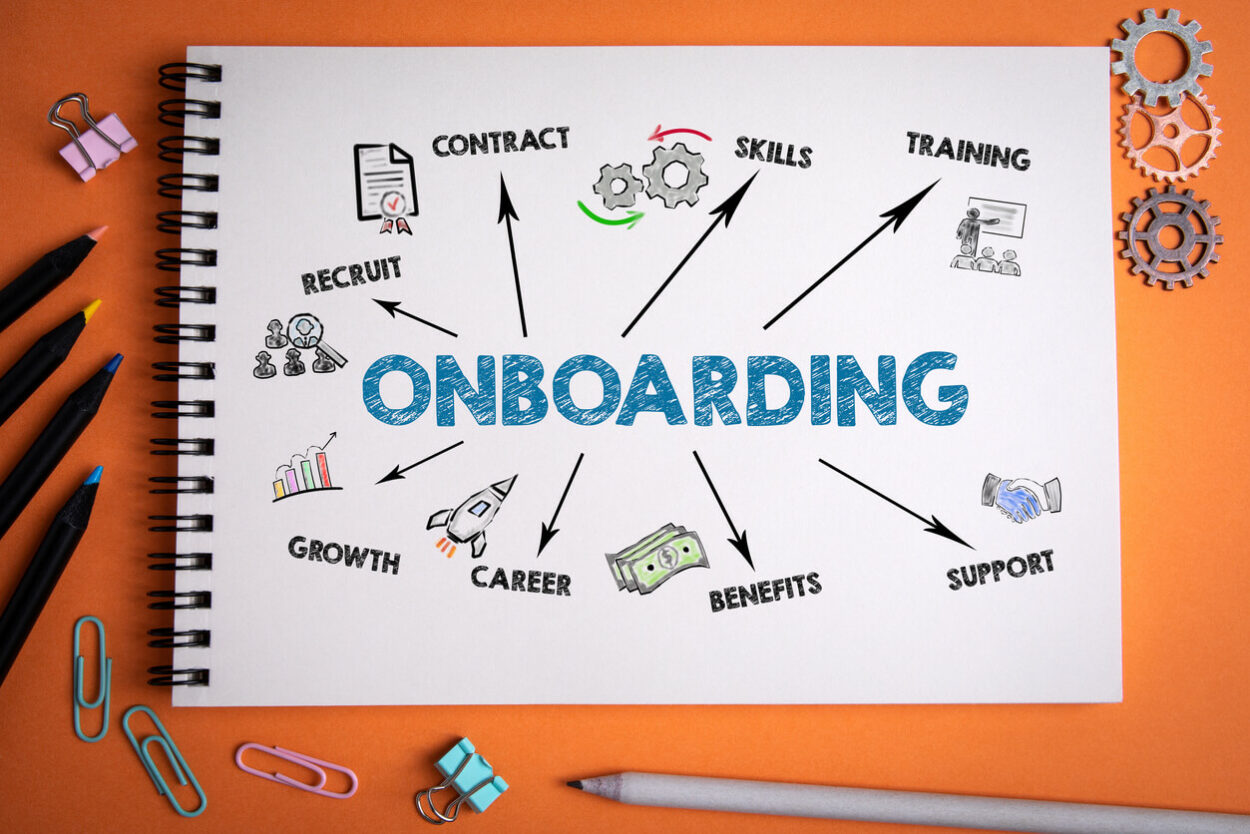Does your company have an employee onboarding strategy in place, or is it a one-time event that happens on your new hire’s first day?
If it’s the latter, it might be time to rethink your onboarding strategy.
For a lot of companies, onboarding looks like a group of new hires participating in an orientation session, signing paperwork, passing out employee handbooks, and maybe a tour.
The truth is that this approach to onboarding is outdated, and it doesn’t set your new hire up for success within your company.
Read on to find out why you need to implement an intentional onboarding strategy in your organization, and what actionable steps you can take to get started.
What is an onboarding strategy?
An onboarding strategy is a systematic approach to welcoming and integrating new employees in your company. The main goal of onboarding strategies is to make your new staff feel welcomed, supported, and prepared for their new role.
Having an onboarding strategy goes beyond filling out paperwork and introducing new hires to their managers. Your new hire should gain an understanding of the company’s culture, values, and expectations, as well as what resources they have available to them.
Your comprehensive onboarding plan starts before your new hire’s first day. It encompasses the onboarding process, which may last weeks or months.
Why you need to have an onboarding strategy
Onboarding is a massively important part of the new hire process. It sets the foundation for employee engagement, job satisfaction, and long-term success with the company.
With historic quit rates and labor shortages, particularly in industries with deskless employees, companies feel mounting pressure to retain staff. TalentCards and When I Work surveyed 900 onboarding managers to gain insight into what they’re experiencing.
Onboarding managers report that within the first 12 months, at least 35% of new hires quit. With 72% of surveyed companies having unfilled positions, that quit rate must be addressed.
One way to combat turnover is through strategic employee onboarding.
Let’s take a deeper look into why this is important:
First impressions matter
Onboarding is your first chance to make a positive impression on your new employee. It’s time to provide them with the necessary skills to do their job and make them excited to stay on board. Now that they’re officially a part of the team, you want to set the tone immediately.
With a solid first impression during onboarding, your new hire may find themselves sharing their positive experiences with their connections. This organically promotes your company’s brand and may even lead to new talent coming your way.
Smooth transitions
No matter how excited your new hire is to start their new role, they’re inevitably going to feel some amount of stress. Put them at ease with a solid onboarding experience. Helping them feel comfortable and confident in their new environment smooths the transition both for your new hire, and for the team that they’re joining.
Increased productivity and engagement
Well-organized onboarding helps employees get quickly up to speed in their new role. They learn about different departments, how everything works together, and the company’s culture.
This smooth integration helps them become productive quickly, therefore reducing the time it takes for your company to gain value from your new members’ contributions.
Enhance employee retention
Effective onboarding can significantly improve employee retention rates. In fact, Employee Onboarding Statistics states that providing a great onboarding experience ensures that 69% of employees stay with a company for three years.
It’s up to your managers and leaders to provide an effective onboarding experience. In doing so, your new hires are more likely to feel engaged, valued, and connected to your business. Reducing the risk of early turnover keeps your staff in place and saves money on recruitment efforts.
Cost savings
When your company has high turnover, productivity is inevitably lost in the process of recruiting, hiring, and training new employees, because these new hires need to replace the employees you’ve lost, instead of contributing to the company’s expansion.
The more experienced an employee is, the greater their loss can be to the company. These employees often take very specific knowledge and best practices that are unique to your business with them, causing this knowledge to be lost.
Retaining long-term employees leads to a more cohesive and high-performing workforce, not only because these employees know the business well, but because they also support the process of passing important knowledge onto your new hires. All of this contributes to increased employee morale, improved productivity, and a stronger employer brand.
Let’s jump into onboarding strategies to help your new hire achieve success.
6 onboarding strategies that help improve employee success
1. Use preboarding to create a positive first impression
Pre-boarding begins before your new hire’s official start date. Set a positive first impression by engaging with recruits before they even step through the door. Ease new job jitters with early interactions. Doing so could make a difference in accepting the job offer.
Both your organization and your new team members benefit from pre-boarding. For companies, it reduces the risk of losing potential employees who may get cold feet and decline your job offer. For new hires, it empowers them by providing essential information ahead of time. This proactive approach builds excitement, enabling employees to hit the ground running on their first day with confidence.
Leveraging pre-boarding is a strategic way to make a lasting positive impression on new hires. By proactively engaging with recruits and preparing them for their upcoming roles, you set the tone for a successful onboarding experience.
2. Instill a culture of learning and development from the beginning
Integrating learning and development (L&D) into the onboarding process is essential for maximizing your new hires’ potential, and ensuring their seamless transition into their roles.
The initial onboarding period provides information about the company and job responsibilities. L&D offers ongoing training and skill development.
According to a report by LinkedIn, 94% of employees said they would stay with a company longer if it invested in their learning and development. Make investing in your staff a part of your brand.
A well-structured L&D program may include software tutorials, videos, and training sessions with managers. For decentralized workforces, choosing the right mobile training platform matters. Meet the needs of your dynamic workforce by engaging them from the beginning.
3. Implement a mentorship program to create connections
Mentorship programs pair new hires with experienced employees who provide guidance, support, and valuable insights into the company’s culture, processes, and best practices. Specifically, they help:
- enhance the onboarding experience
- foster employee engagement
- promote a sense of belonging within the organization
With a mentor, new employees navigate their roles more effectively, ask questions freely, and gain a deeper understanding of the organization.
The members of your team who you select to be mentors should possess relevant skills and experience. Above all else, there needs to be a compatible communication style with the mentee.
Be sure you monitor the progress of your program by having regular check-ins. Feedback will help identify areas for improvement while ensuring everyone gains value from the program.
4. Set the tone with your orientation program
Make your new employees feel welcomed and supported as they begin their journey with your company.
Let’s go over some of the key components of a robust orientation program:
Pre-orientation materials
Provide new hires with orientation materials before their first day. This could include a welcome package, company handbook, and other relevant documents that can help them familiarize themselves with the company’s policies and procedures.
Workspace preparation
Ensure the new hire’s workspace is ready and equipped with all the necessary resources to start working immediately. They can access relevant software, hardware, and other essential materials.
Virtual onboarding
Consider conducting virtual onboarding sessions if your organization operates remotely or has a hybrid work environment. Tailor what you cover to the unique needs of your organization. Provide information about the company, its culture, and what’s to come.
Interactive sessions
Incorporate interactive sessions into the orientation program to engage new employees. Include team-building activities, introductions to key team members, and opportunities for new hires to ask questions.
Feedback and follow-up
Regularly seek feedback from new hires about their onboarding experience. Use this feedback to make improvements and address any concerns they may have. Additionally, follow up with new employees after the initial onboarding period to ensure their continued success.
5. Pacing: timing is everything
When planning your onboarding, it’s vital to consider the pacing. Move too quickly, and you risk overwhelming your new hire. Go too slow, and they might lose interest.
Here’s how to implement an effective onboarding process at a steady pace:
Have a balanced timeline
Gradually introduce essential information, training, and introductions over the initial weeks or months. This steady approach allows new hires to absorb and retain information effectively.
Mix learning and hands-on experiences
Provide high-quality education while allowing opportunities to apply knowledge in real-world tasks. This gradual release will instill confidence in your new staff.
Use a goal-oriented approach
Set clear and achievable goals for new hires within a 30-60-90 day span. Align these goals with the company’s objectives to provide direction and purpose for the employees.
Provide managerial support
Ensure managers actively support new employees, providing continuous feedback and open communication channels. This support helps new hires feel valued and invested in their professional growth.
Encourage networking
Lonely employees are far less productive, far more burnt out, and have a high attrition rate. Combat this early on by facilitating networking opportunities. Do this in person or through an online platform for your workers in the field.
Support continuous learning
L&D doesn’t stop after the initial onboarding stage. Create an environment of continuous learning by offering access to resources, workshops, and mentorship programs. One way to do so is to have a mobile training platform in place that puts learning in your staff’s hands (and pockets).
6. Leverage onboarding surveys
An often overlooked part of onboarding is the onboarding survey. At specific times during the onboarding process, you can deploy a survey to see how things are going. You’re accomplishing a couple of things with this:
First, you clearly convey to your staff that you care about what they have to say. By asking them targeted questions, the lines of communication are open.
Second, you can adjust your process using the responses to make improvements.
Asking the right questions at the right time makes all the difference.
How to reach your deskless workforce
Onboarding managers face unique challenges when training deskless new hires. Lack of time and access to training materials are two commonly reported obstacles.
Despite making up 80% of the global workforce, decentralized workers have yet to be prioritized in training and onboarding methods.
Thirty-two percent of onboarding managers reported not having enough time to properly train new employees, while 27% have difficulties making training materials easily accessible.
Finding and implementing the right tech will solve these, and many other challenges.
TalentCards offers mobile training software made specifically for deskless workers. You can try it completely for free and change how your employees learn.
Create training resources that your employees can take anywhere

FAQs
What are the 5 C’s of strategic onboarding?
The 5 C’s of strategic onboarding are:
- Compliance
- Clarification
- Confidence
- Connection
- Culture
Focusing on the 5 C’s has been shown to improve onboarding outcomes.
What are the 4 C’s of effective onboarding?
Compliance, clarification, connection, and culture. The 4 C’s are the same as the 5 C’s, but just leave out confidence. It’s up to each organization which one fits their needs.
What are the 4 phases of onboarding?
Preboarding, onboarding, training, and transition to the new role.
What are the best onboarding strategies?
- Have a preboarding process in place
- Make learning and development a part of your culture
- Establish a mentorship program
- Provide intentional orientation
- Pace employee onboarding correctly
- Leverage onboarding surveys to improve your process
Successful onboarding strategies lead to positive outcomes
You can’t build a house on sand. A strong foundation leads to a lasting home. The same is true for your new hires. They are far more likely to succeed when properly onboarded using intentional strategies paired with the right training platform.
Key takeaways
- Your employee onboarding strategy needs to be well thought out and intentional.
- Strategic employee onboarding can help reduce turnover.
- Some strategies to implement are preboarding, learning and development, mentorships, orientation, pacing, and surveys.
- Deskless workers are the largest workforce and the most underserved regarding onboarding and training. One way to change this is by implementing a mobile training platform.


